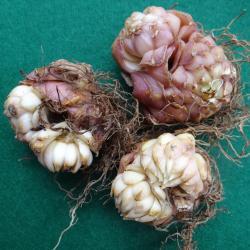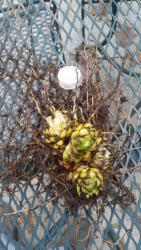@Oberon46, yes sharp sand, this is also called builders sand. This is made from crushed rock material. However this isn't really crucial, the important thing is that the grain size isn't too small.
The idea actually isn't to mix sharp sand with soil, it's to grow in pure sharp sand and nothing else. The air space between the grains are what matters here, so I don't think perlite would make this mix any better. Perlite is more for mixing with soil and you will not use any soil here!
I don't know what fractions of sand you have available locally, but around 0-6 millimetres is pretty good from what I read. I'd try to make sure that there isn't salt, clay or other nasty stuff in it. A good seller would know this. This is normally fairly cheap stuff, cheaper than buying good soil when you buy it in bulk.
Of course there are many opinions about how to build the ultimate sand bed, so techniques could vary but...
Personally If I were you and wanted to try this, I'd leave the peonies in and only replace the soil with sharp sand were you wanted to plant lilies. It won't be absolutely necessary to rise the bed further up. Just dig out the soil to around a feet or a little more if the drainage is poor and refill with pure suitable sand of your choice. Leave enough space to put 4 inches of grass mulch on top and refill this continuously during the summer. When you refill you should of course make sure to leave a little room to the stalks. It's good if the grass cuttings aren't too short as it could end up too compact. You could also grind weeds and put this in, but it wouldn't look as tidy. This is supposed to be used fresh and green as it will have the most nutrition then. Closer to the autumn you could use a little older material.
I noted that the Swedish garden writer that made this method known here devoted a good section to lilies and recommended to mulch directly after planting (in spring, as this is the usual time for planting here, simply because bulbs aren't usually available in the autumn) and then help the emerging shoots to break free of the mulch, if necessary.
In the autumn it's good to mix a little leaf into the grass mulch. For winter covering he - like Lorn - liked using boughs (he used
Picea abies, Norway spruce to a depth of 4 inches).
Then there of course is other sharp sand methods, that doesn't involve covering with grass cuttings, but is to improve hardiness as well.
Se for instance Ian Young's Bulb Blog:
http://www.srgc.org.uk/logs/lo...
Or for links to all his blogs:
http://www.srgc.org.uk/logs/
So there are many possibilities and this method is also very good for rainy areas such as Scotland where Ian Young is located or perhaps for folks in the PNW region that would have issues with too much moisture during winter.
BTW there is a big difference between spreading out grass cuttings and other greens than storing it in a pile. The pile will heat up a lot, but when you spread this out, it won't be a problem. I have in the past mulched with grass cuttings and it's really excellent. The only reason I don't do it as much these days are that I don't usually collect the grass cuttings any longer. If I had enough material, I'd still do it!

